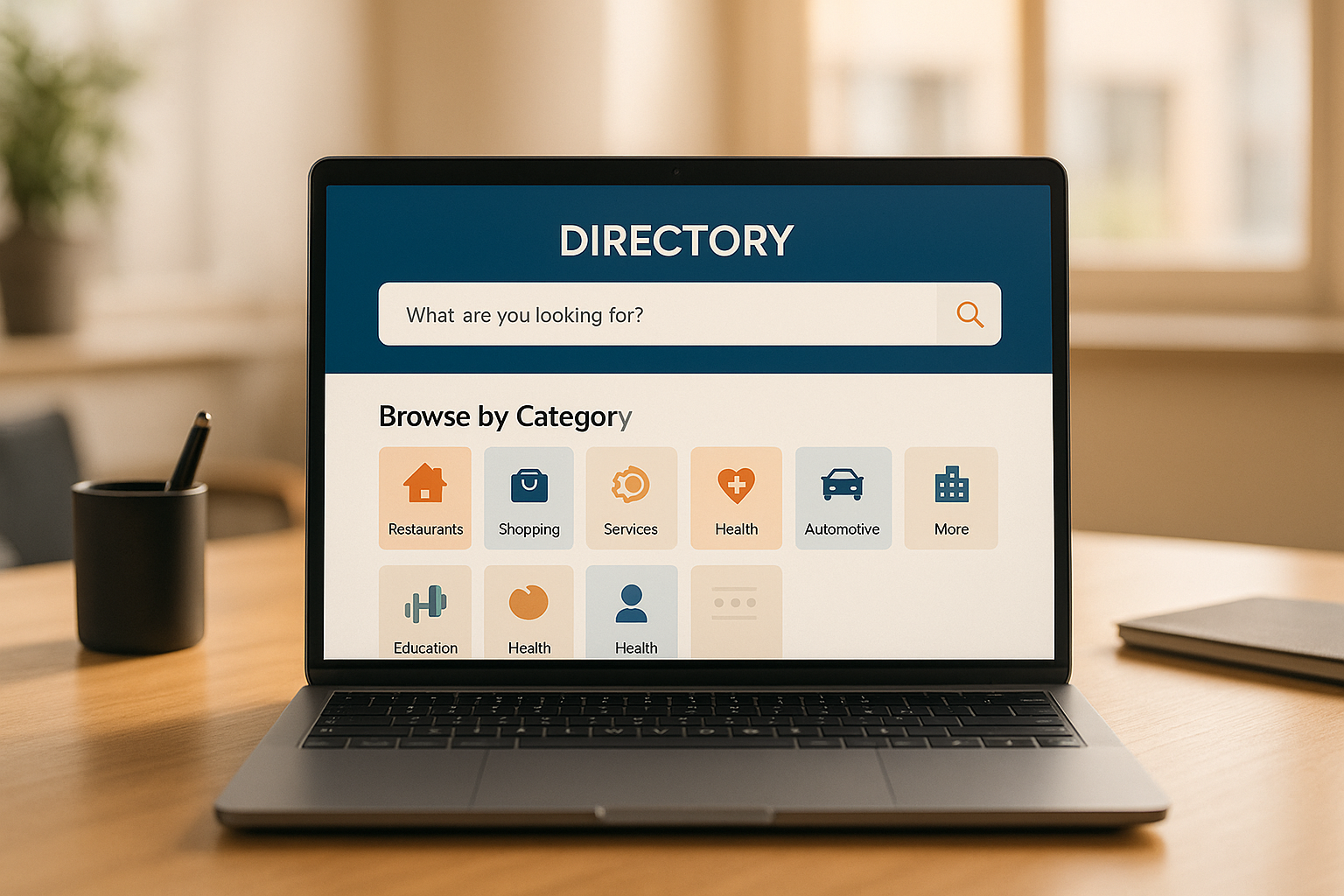
| Problem Area | Key Fixes | Benefits |
|---|---|---|
| Mobile Usability | Compress images, use responsive layouts | Faster load times, better UX |
| SEO Performance | Write unique content, fix duplicate URLs | Higher search rankings |
| Data Management | Automate imports, verify updates | Accurate and up-to-date data |
| Monetization | Add premium listings, ads, memberships | Stable revenue streams |
| User Experience | Simplify navigation, improve search features | Better engagement and retention |
By addressing these issues, directory websites can improve usability, attract more visitors, and increase revenue.
Poor design can hurt user engagement and limit the success of your directory website.
Standard templates often limit how much you can personalize your site, making it harder to reflect your brand. To stand out, focus on these customization areas:
By including high-contrast text, clear calls-to-action (CTAs), and consistent branding, you can enhance the site's professionalism. But addressing template limitations is just one piece of the puzzle - mobile usability is equally critical.
Mobile users expect pages to load in under 3 seconds [1]. To meet these expectations, focus on solving common mobile issues:
| Mobile Issue | Solution | Impact |
|---|---|---|
| Slow Loading | Compress images, use a CDN, and enable lazy loading | Reduces bounce rates and improves SEO |
| Touch Target Size | Ensure buttons are at least 48px × 48px | Improves interaction accuracy |
| Content Readability | Use responsive images and flexible layouts | Enhances user experience |
| Navigation | Add collapsible menus and a clear search option | Makes content easier to find |
"Let's not kid ourselves - if your website isn't mobile-friendly in 2024, it's practically invisible." – Balraj Singh, Software Engineer [1]
To improve mobile performance, consider these steps:
Progressive Enhancement
Use modern technologies like service workers and progressive web apps (PWAs) to speed up loading times and allow offline access. This ensures your site works even on slower networks.
Image Optimization
Switch to modern formats like WebP and use responsive image techniques such as the <picture> element or srcset attribute. Tools like TinyPNG can help reduce file sizes without losing quality.
Simplify Navigation
Design menus that are easy to use with one hand. A well-implemented hamburger menu and a prominent search bar can help users quickly find the listings they need.
SEO issues can hurt your website's visibility and traffic. Below are some common challenges and practical ways to address them.
Duplicate content can harm your search rankings and dilute link value. This is a common problem for directory listings, where descriptions often look too similar.
| Issue | Solution | Implementation |
|---|---|---|
| Similar Listing Descriptions | Write unique content for each listing | Create original descriptions tailored to each listing |
| Multiple URL Versions | Use 301 redirects | Redirect different URL versions to a single canonical URL |
| Paginated Content | Add rel="prev/next" tags or indexing directives | Implement proper pagination markup |
| Category Overlaps | Simplify category structure | Assign unique meta descriptions for each category |
"Our users typically want to see a diverse cross-section of unique content when they do searches. In contrast, they're understandably annoyed when they see substantially the same content within a set of search results." - Google [3]
A well-organized site structure is just as important as unique content for improving SEO.
/restaurants/italian/manhattan/luigi-trattoria instead of /l/123456."If you're internally linking for no reason, stop. If you're internally linking with purpose, great!" - Zaine [4]
Use tools like Google Search Console to identify and resolve problems quickly. Focus on crafting unique and meaningful content for each listing. As John Mueller from Google explains: "With directories like that, I always worry that it's very easy to create a ton of content that doesn't have a lot of value yet... I am missing anything unique, compelling, and of high quality." [2]
Improving user experience is crucial to keep visitors engaged. Even with great design and SEO, poor usability can drive people away.
Good navigation helps users find what they need quickly and easily. A well-structured menu can make a big difference in how visitors interact with your site.
| Navigation Element | Purpose | Tips for Implementation |
|---|---|---|
| Main Menu | Primary navigation | Keep it concise with 4-5 key items [5] |
| Breadcrumbs | Show user location | Use clear hierarchies like "Restaurants > Italian > Manhattan" |
| Mobile Menu | Simplify access | Focus on essential features for smaller screens |
| Back to Top | Navigate long pages | Add a floating button for easy scrolling |
Breadcrumb navigation is especially helpful for complex directories. For example: Home > Restaurants > Italian > Manhattan > Luigi's Trattoria. This layout makes it easy for users to backtrack without confusion.
Remember, smooth navigation also depends on fast-loading pages to keep things seamless.
Page speed is critical - just a 1-second delay can slash conversions by 7% [6]. To boost performance:
"Website speed optimization starts way before you have an actual website." - Deyan Georgiev, Co-founder and CEO, NitroPack [7]
Once speed and navigation are addressed, adding a strong search feature can take the user experience even further.
With 82% of smartphone users including "near me" in their searches [9], integrating location-based search is more important than ever.
Enhance your website's search capabilities by adding:
"In a nutshell, search functionality on your website helps offer a smooth, consistent experience for your users. And a well-implemented search functionality has more potential to ensure the website's success." - Neha Vyas [8]
Boosting user engagement and improving site performance can directly increase your directory website's earning potential. To monetize effectively, you need careful planning and a mix of revenue streams.
Diversifying income sources helps create a more stable and profitable business. Here are some common ways directory owners generate revenue:
| Revenue Stream | How It Works | Typical Results |
|---|---|---|
| Premium Listings | Offer tiered pricing with added features | 15–25% conversion from free to paid [10] |
| Membership Access | Provide exclusive content and verified listings | Recurring monthly revenue |
| Lead Generation | Sell qualified business leads to companies | $50–99 per campaign [10] |
| Advertising Space | Place targeted ads in high-traffic areas | Additional passive income |
| Affiliate Marketing | Partner with related service providers | Commission-based earnings |
To make the most of these streams, ensure you're delivering real value. For instance, premium listings should include perks like better visibility, detailed business profiles, and priority search placement.
"The more traffic you bring to your site, the easier it will be to monetize your business directory or any online venture." – GeoDirectory [10]
Turning free listings into paid accounts requires showing business owners the clear benefits of upgrading. Here's how you can make that happen:
Strategic Outreach
Value-Added Features
A great example of this approach is Connor Finlayson's Unicorn Factory directory in New Zealand. Launched in February 2025, it started with a freemium model before moving to paid listings. This strategy helped them build a strong user base and prove the value of their service before fully monetizing [11].
Consider using a tiered pricing model to appeal to different types of businesses:
| Feature Level | Included Benefits | Target Audience |
|---|---|---|
| Basic Listing | Basic details (name, address, phone), one category | Small businesses |
| Enhanced | Photos, detailed descriptions, multiple categories | Growing companies |
| Premium | Featured placement, lead generation, analytics | Established businesses |
Handling large amounts of directory data comes with its own set of challenges. Research indicates that over 70% of local businesses have some type of online directory presence [12]. This makes efficient data management a key factor in ensuring a website's success.
Speeding up data entry not only saves time but also minimizes errors. Here are some commonly used methods by directory websites:
| Method | Benefits | Cost |
|---|---|---|
| Automated Import Tools | Bulk data import from trusted sources | $30–120/month [13] |
| Outsourced Data Entry | High accuracy with quicker turnaround | Starting at $6/hour [14] |
| API access Integrations | Real-time data synchronization | Varies by provider |
For instance, automated import tools can pull data directly from platforms like Google Maps, including details, photos, and reviews. This not only speeds up the process of creating listings but also ensures accuracy [13].
It's equally crucial to make it easy for users to update their listings whenever needed.
Allowing businesses to update their listings while maintaining quality requires a thoughtful approach. Here are some effective practices:
A multi-step verification system has been shown to reduce unauthorized changes by 92% [15]. This system combines automated checks with manual reviews for sensitive updates.
| Update Type | Verification Level | Processing Time |
|---|---|---|
| Basic Info | Email verification | Instant |
| Contact Details | Phone verification | 1–2 hours |
| Ownership Claims | Document review | 24–48 hours |
To maintain data quality, consider implementing:
By tackling challenges in design, SEO, user experience, monetization, and data management, directory websites can achieve impressive outcomes. Below is a quick look at practical solutions:
| Challenge Area | Key Solutions | Impact |
|---|---|---|
| Design & Mobile | Custom themes; Mobile-first design | Better usability on all devices |
| SEO Performance | pSEO pages; Sitemaps; Rich snippets | Higher search rankings |
| Data Management | Automation tools; Data validation | Easier listing management |
| Monetization | paid submissions system | Reliable revenue sources |
These approaches align with earlier strategies discussed for improving design, SEO, and monetization. Many directories - over 1,000, in fact - have seen success by:
When combined, these methods help directory owners boost performance and generate revenue. A user-friendly interface further enhances long-term growth and success.
"Directify handles all hosting and deployment, so you don't need to manage servers or hosting details. You can focus entirely on creating and maintaining your directory."
Start creating your professional directory website today with Directify's no-code platform.
Get Started Free





